battery drain on excursion
Printed From: the12volt.comForum Name: Car Audio
Forum Discription: Car Stereos, Amplifiers, Crossovers, Processors, Speakers, Subwoofers, etc.
URL: https://www.the12volt.com/installbay/forum_posts.asp?tid=135155
Printed Date: December 26, 2025 at 3:29 AM
Topic: battery drain on excursion
Posted By: 02excursion
Subject: battery drain on excursion
Date Posted: October 27, 2013 at 9:21 AM
Hello all,
New to this site. Forgive me if this has been asked before, but i wasnt able to find the answer through a basic search?
I own a 2002 excursion diesel 7.3
(2)Batteries are around 40 months old
Viper remote start
Milion d223b
Jl audio 1000/1
Jl audio 12w7
Dc power 185 High Output alternator
I had a local stero guy install a milion d223b head unit in my 02 Excursion a year ago. About two months ago i started noticing my batteries starting to get weaker when firing up my beast. On friday my beast was complety dead, i started googling for a parastic draw on my batteries after watching many videos on how to properly perform one i narrowed it down to my head unit. Once i unplugged the wiring harness the draw fell to around ~40 ma.
I then cut the constant battery wire at the head unit to the wire hareness plugged in the head unit and checked again for the battery draw and it stayed at ~40 ma..
My question is do i need to have the constant battery wire connected?
I temporily connected the constant battery wire with the backup 12v wire and now the radio only turns on when the lights are on and all my presets are gone?
Please help out this noob.......love this site.
Thanks in advance.
02EX
New to this site. Forgive me if this has been asked before, but i wasnt able to find the answer through a basic search?
I own a 2002 excursion diesel 7.3
(2)Batteries are around 40 months old
Viper remote start
Milion d223b
Jl audio 1000/1
Jl audio 12w7
Dc power 185 High Output alternator
I had a local stero guy install a milion d223b head unit in my 02 Excursion a year ago. About two months ago i started noticing my batteries starting to get weaker when firing up my beast. On friday my beast was complety dead, i started googling for a parastic draw on my batteries after watching many videos on how to properly perform one i narrowed it down to my head unit. Once i unplugged the wiring harness the draw fell to around ~40 ma.
I then cut the constant battery wire at the head unit to the wire hareness plugged in the head unit and checked again for the battery draw and it stayed at ~40 ma..
My question is do i need to have the constant battery wire connected?
I temporily connected the constant battery wire with the backup 12v wire and now the radio only turns on when the lights are on and all my presets are gone?
Please help out this noob.......love this site.
Thanks in advance.
02EX
Replies:
Posted By: oldspark
Date Posted: October 27, 2013 at 4:55 PM
Your batteries may simply be at end of life. Have them tested.
I assume your HU turn off with ign or acc off (ie, so const +12V and switched +12V are not BOTH getting +12V when supposedly off "off".) 40mA IMO is high but, but some alternators alone consume 12mA just sitting there.
If your charging voltage at the battery terminals sits between 13.8 to 14.4V (preferably 14.2-14.4 for good battery life) at typical RPM & loads, then your alternator is probably charging ok.
I assume you are using a battery isolator? Permanent paralleling of batteries shortens their life.
I assume your HU turn off with ign or acc off (ie, so const +12V and switched +12V are not BOTH getting +12V when supposedly off "off".) 40mA IMO is high but, but some alternators alone consume 12mA just sitting there.
If your charging voltage at the battery terminals sits between 13.8 to 14.4V (preferably 14.2-14.4 for good battery life) at typical RPM & loads, then your alternator is probably charging ok.
I assume you are using a battery isolator? Permanent paralleling of batteries shortens their life.
Posted By: Ween
Date Posted: October 27, 2013 at 5:59 PM
hi,
for the current draw, i agree 40mA may seen a bit high. disable/disconnect the remote start and recheck. the draw may reduce slightly. as for the batteries in parallel, the big 3 automakers here
wire the batteries that way on the diesel powerplant models.
mark
for the current draw, i agree 40mA may seen a bit high. disable/disconnect the remote start and recheck. the draw may reduce slightly. as for the batteries in parallel, the big 3 automakers here
wire the batteries that way on the diesel powerplant models.
mark
Posted By: oldspark
Date Posted: October 27, 2013 at 10:14 PM
I know of older duals that series-switched 12V diesels for 24V starters, but parallel 12V for double the current into the same power 12V starters is simpler as well as being less than half the battery "strain", tho they should still follow normal battery isolation when not being used - even if they don't do it as OEM. Maybe OEM have matched batteries or found that their batteries last long enough...
But one bad battery will bring down a good battery so vigilant monitoring is suggested (eg, weekly voltage - & temperature tests if AGM), but auto-isolation overcomes that and means you can test each battery's voltage and hence determine if partly discharged or collapsing cells, or even a bad alternator.
It still unnerves me when I hear of permanently paralleled AGM batteries that do not have temp sensing or other monitoring or alerts - even if people aren't dumb enough to mix new with old.
But one bad battery will bring down a good battery so vigilant monitoring is suggested (eg, weekly voltage - & temperature tests if AGM), but auto-isolation overcomes that and means you can test each battery's voltage and hence determine if partly discharged or collapsing cells, or even a bad alternator.
It still unnerves me when I hear of permanently paralleled AGM batteries that do not have temp sensing or other monitoring or alerts - even if people aren't dumb enough to mix new with old.
Posted By: 02excursion
Date Posted: October 31, 2013 at 4:09 PM
oldspark wrote:
Your batteries may simply be at end of life. Have them tested.
I assume your HU turn off with ign or acc off (ie, so const +12V and switched +12V are not BOTH getting +12V when supposedly off "off".) 40mA IMO is high but, but some alternators alone consume 12mA just sitting there.
If your charging voltage at the battery terminals sits between 13.8 to 14.4V (preferably 14.2-14.4 for good battery life) at typical RPM & loads, then your alternator is probably charging ok.
I assume you are using a battery isolator? Permanent paralleling of batteries shortens their life.
Here is my update.....on my parasitic draw.
Just to be safe I replaced both batteries yesterday and i didn't have any starting issues this morning.
The Hu is off when the ign or acc is off. The ~40 ma draw seems to be consistent with what i have been reading on the net.
To my knowledge im not using a battery isolator?
02EX
Posted By: 02excursion
Date Posted: October 31, 2013 at 4:11 PM
Ween] wrote:
hi,
for the current draw, i agree 40mA may seen a bit high. disable/disconnect the remote start and recheck. the draw may reduce slightly. as for the batteries in parallel, the big 3 automakers here
wire the batteries that way on the diesel powerplant models.
mark
Ween,
I will test my draw with disabling my remote starter and alternator this weekend.
02EX
Posted By: 02excursion
Date Posted: October 31, 2013 at 6:50 PM
Had family visit me for the week, so i apologize for going idle on this thread.
I still need help.....Hu will only power on when I turn on my lights? How do i get around that without connecting the constant 12V wire (which was causing my parasitic draw).
02EX
I still need help.....Hu will only power on when I turn on my lights? How do i get around that without connecting the constant 12V wire (which was causing my parasitic draw).
02EX
Posted By: oldspark
Date Posted: October 31, 2013 at 10:46 PM
So it is the HU's const +12V that is drawing 40mA when the HU is off with the HU +12V switched input off or disconnected?
If so, the HU is bad or a bad design or there is some other wiring fault causing this.
When the const +12V is cut, the HU will lose its memory. (Exceptions are when the ON switched +12V can also hold memory, or if the HU has some internal capacitance or battery to hold the memory for a while.)
Memories should only take a few mA if that.
My Alpine draws ~120mA with both const & switched = 12V so I can't leave the switched +12V permanently oonnected.
Because I want IGN independence, I wired ACC/IGN +12V thru a diode to a relay coil to switch switched +12V to the HU. Also the HU's remote on (output) via a diode to the same relay. Hence once the HU is switched on (with IGN), it will stay on until turned off at the faceplate. (I also intend to fit switches to return to normal "IGN off HU off" operation, and one to bypass the need for IGN altogether.)
If so, the HU is bad or a bad design or there is some other wiring fault causing this.
When the const +12V is cut, the HU will lose its memory. (Exceptions are when the ON switched +12V can also hold memory, or if the HU has some internal capacitance or battery to hold the memory for a while.)
Memories should only take a few mA if that.
My Alpine draws ~120mA with both const & switched = 12V so I can't leave the switched +12V permanently oonnected.
Because I want IGN independence, I wired ACC/IGN +12V thru a diode to a relay coil to switch switched +12V to the HU. Also the HU's remote on (output) via a diode to the same relay. Hence once the HU is switched on (with IGN), it will stay on until turned off at the faceplate. (I also intend to fit switches to return to normal "IGN off HU off" operation, and one to bypass the need for IGN altogether.)
Posted By: 02excursion
Date Posted: November 02, 2013 at 11:06 AM
oldspark wrote:
So it is the HU's const +12V that is drawing 40mA when the HU is off with the HU +12V switched input off or disconnected?
If so, the HU is bad or a bad design or there is some other wiring fault causing this.
When the const +12V is cut, the HU will lose its memory. (Exceptions are when the ON switched +12V can also hold memory, or if the HU has some internal capacitance or battery to hold the memory for a while.)
Memories should only take a few mA if that.
My Alpine draws ~120mA with both const & switched = 12V so I can't leave the switched +12V permanently oonnected.
Because I want IGN independence, I wired ACC/IGN +12V thru a diode to a relay coil to switch switched +12V to the HU. Also the HU's remote on (output) via a diode to the same relay. Hence once the HU is switched on (with IGN), it will stay on until turned off at the faceplate. (I also intend to fit switches to return to normal "IGN off HU off" operation, and one to bypass the need for IGN altogether.)
oldspark,
It's definitely the const +12V wire that is causing my parasitic draw (see picture below)I temporally connected it again and my meter read ~5.21 (please advise if I set the centech multimeter correctly)
Here is picture with const +12V connected.
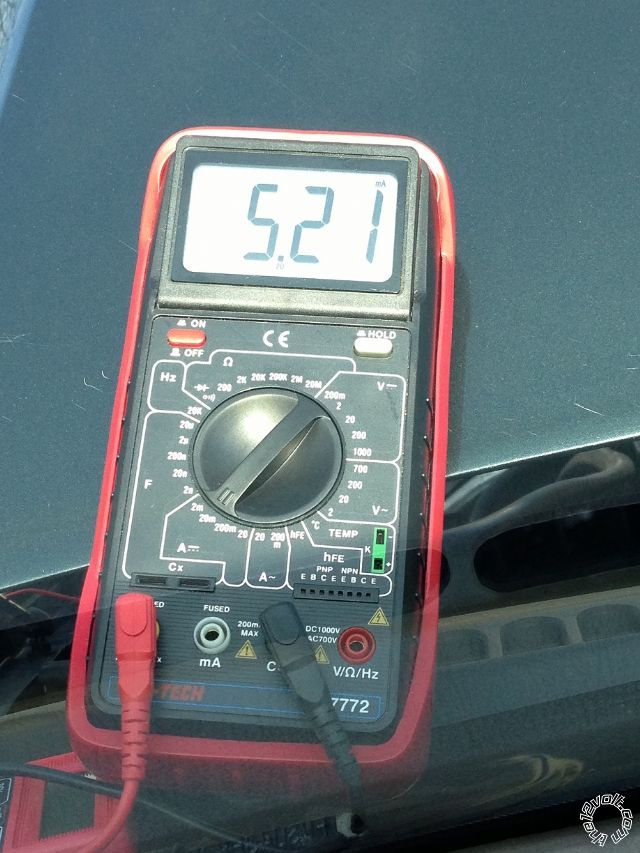
and here is a picture of the the const +12V unplugged.
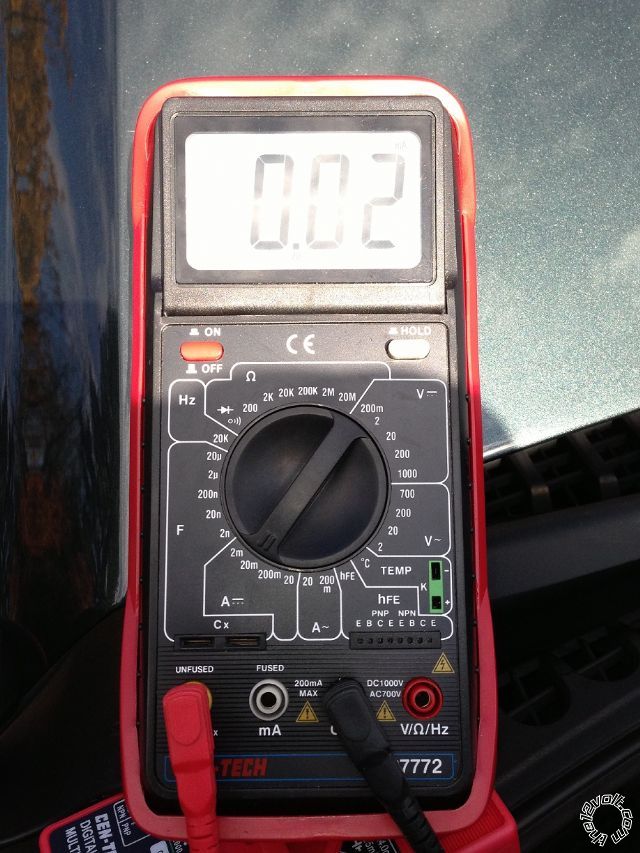
Is there a way I can get around this parasitic draw while still keeping my pre-sets and preferences on the HU? It also sucks having to turn on my lights for the HU to power on the way i currently have it connected?
btw as you can tell I'm a bit of a noob with the lingo, pictures or videos for me are a big plus.
Thanks
02EX
Posted By: oldspark
Date Posted: November 02, 2013 at 5:36 PM
I question the +ve lead socket. Usually that furthest left socket is unfused for 10A, or in your case, 20A. The mA ranges use the normal (fused) socket but in your case, the 2nd left "fused mA" socket.
The proper socket can make a big difference. IE - a DMM spec'd with 1% accuracy on a 20A scale can mean 1% of 20A = 200mA which means your 5.21mA could be anywhere from -195mA to 205mA.
If the 5.21mA is correct, then the drain is ok. 5mA is typical of a LED or less, and 1/50th of a typical Automotive relay or 3W bulb.
IOW negligible. (Even some alternators consume over 10mA "parasitically".)
And no - you can't get around that parasitic draw. That is the current required to keep the HU's memory and any supervisory stuff (USB connections etc). IMO HUs should have non-volatile memory (that does not require power) for at least tuning (with a reset button).
The only issue is if that draw varies - eg, my Alpine which when off draws ~120mA-140mA if BOTH const & switched +12V are connected but only a few mA if only one is connected. Hence I can no longer wire BOTH to +12V like I used to do, and hence the relay that connects the switched to const (whenever it is energised by IGN or ACC +12V, or a manual switch, or the HU's remote output).
The proper socket can make a big difference. IE - a DMM spec'd with 1% accuracy on a 20A scale can mean 1% of 20A = 200mA which means your 5.21mA could be anywhere from -195mA to 205mA.
If the 5.21mA is correct, then the drain is ok. 5mA is typical of a LED or less, and 1/50th of a typical Automotive relay or 3W bulb.
IOW negligible. (Even some alternators consume over 10mA "parasitically".)
And no - you can't get around that parasitic draw. That is the current required to keep the HU's memory and any supervisory stuff (USB connections etc). IMO HUs should have non-volatile memory (that does not require power) for at least tuning (with a reset button).
The only issue is if that draw varies - eg, my Alpine which when off draws ~120mA-140mA if BOTH const & switched +12V are connected but only a few mA if only one is connected. Hence I can no longer wire BOTH to +12V like I used to do, and hence the relay that connects the switched to const (whenever it is energised by IGN or ACC +12V, or a manual switch, or the HU's remote output).
Posted By: oldspark
Date Posted: November 02, 2013 at 5:55 PM
Further to above, if the const +12V input takes 5mA, check for other drains from the battery.
Maybe using the high-Amp (20A, else 10A) for an initial confirmation, and then remeasuring on a mA scale once <200mA is confirmed, the way I do it (on the mA scale) is...
- loosen the +ve battery terminal but leave connected.
- the -ve terminal can be used instead if the +ve is too difficult or cluttered.
- with one test probe on the battery terminal and the other on the battery post (either under, or thru the terminal's post hole), remove the terminal.
Hence current continues to flow but thru the DMM.
The reason for the above "no break" measurement is that sometimes after a battery disconnect there is a high inrush current upon reconnection (capacitors for some audio systems; other circuits) that could be too high for the mA range.
BTW - I have learned to carry spare fuses. Many DMMs use a 200mA or 250mA fuse, typically a "205" (20mm x 5mm) type.
Maybe using the high-Amp (20A, else 10A) for an initial confirmation, and then remeasuring on a mA scale once <200mA is confirmed, the way I do it (on the mA scale) is...
- loosen the +ve battery terminal but leave connected.
- the -ve terminal can be used instead if the +ve is too difficult or cluttered.
- with one test probe on the battery terminal and the other on the battery post (either under, or thru the terminal's post hole), remove the terminal.
Hence current continues to flow but thru the DMM.
The reason for the above "no break" measurement is that sometimes after a battery disconnect there is a high inrush current upon reconnection (capacitors for some audio systems; other circuits) that could be too high for the mA range.
BTW - I have learned to carry spare fuses. Many DMMs use a 200mA or 250mA fuse, typically a "205" (20mm x 5mm) type.
Posted By: 02excursion
Date Posted: November 02, 2013 at 8:00 PM
oldspark wrote:
I question the +ve lead socket. Usually that furthest left socket is unfused for 10A, or in your case, 20A. The mA ranges use the normal (fused) socket but in your case, the 2nd left "fused mA" socket.
The proper socket can make a big difference. IE - a DMM spec'd with 1% accuracy on a 20A scale can mean 1% of 20A = 200mA which means your 5.21mA could be anywhere from -195mA to 205mA.
If the 5.21mA is correct, then the drain is ok. 5mA is typical of a LED or less, and 1/50th of a typical Automotive relay or 3W bulb.
IOW negligible. (Even some alternators consume over 10mA "parasitically".)
And no - you can't get around that parasitic draw. That is the current required to keep the HU's memory and any supervisory stuff (USB connections etc). IMO HUs should have non-volatile memory (that does not require power) for at least tuning (with a reset button).
The only issue is if that draw varies - eg, my Alpine which when off draws ~120mA-140mA if BOTH const & switched +12V are connected but only a few mA if only one is connected. Hence I can no longer wire BOTH to +12V like I used to do, and hence the relay that connects the switched to const (whenever it is energised by IGN or ACC +12V, or a manual switch, or the HU's remote output).
oldspark,
I will recheck my parasitic draw using the 2nd left "fused mA socket". An aftermarket wiring harness (not sure of the brand) was used to "plug and play" this HU.
My question is where should the remote lead "wire" from the amp be connected too? I was looking at deck and I didn't see a reference for this wire? I'm wondering if somehow my jl audio 1000/1 is getting power when the const +12V is connected via the remote lead and its staying on when the key is on the off position?
I have included a picture below of the deck wiring diagram.
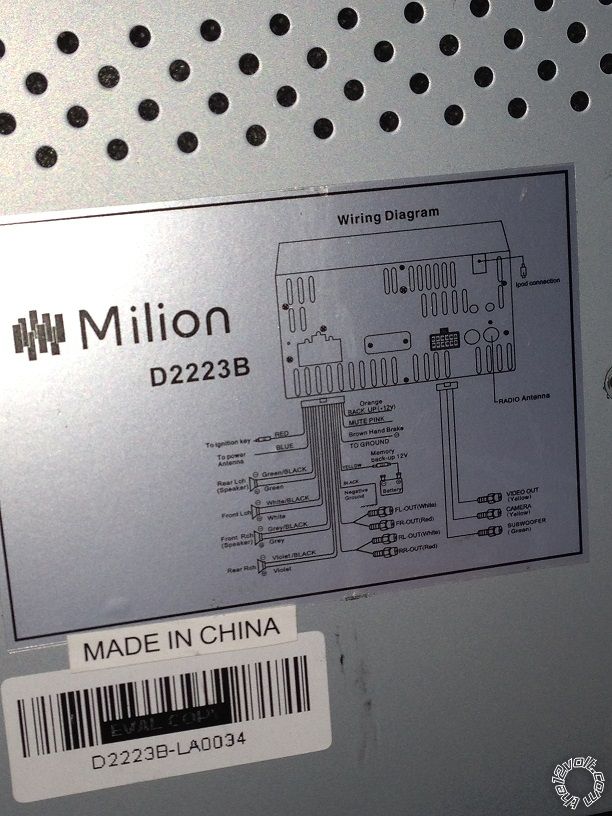
I will upload some additional pictures of where the remote lead is connected to tomorrow if I can find it?
This is driving me nuts.....but i appreciate the help I'm getting here.
Thanks again
02EX
Posted By: oldspark
Date Posted: November 02, 2013 at 8:27 PM
The HU "remote" is an output to turn on external amplifiers if fitted. I use it to keep the HU power on when IGN is off by keeping the "connect cont +12V to HU switched +12V".
But are you sure you have a problem? The 5mA drain is ok.
Maybe your batteries dying of age coincided with the new HU and nothing more.
A prudent check may be the batteries themselves. I'd assume BOTH were replaced since permanently paralleled batteries (as well as series for 24V systems) must be matched - certainly not new with old.
Maybe one battery is defective.
A full battery should measure ~12.67V with no load (aka OC - Open Circuit) assuming surface charge has dissipated. (This can read up to ~13.7V and may take 24 hours to dissipate normally, or a few minutes with a load (headlights etc).)
If you isolate the batteries (break their +12V interconnection) they should have the same voltage for days (or weeks) excluding any drains. Either or both yous might have drains - eg, alternator's voltage regulator Sense; HU; alarms; central locking.
But are you sure you have a problem? The 5mA drain is ok.
Maybe your batteries dying of age coincided with the new HU and nothing more.
A prudent check may be the batteries themselves. I'd assume BOTH were replaced since permanently paralleled batteries (as well as series for 24V systems) must be matched - certainly not new with old.
Maybe one battery is defective.
A full battery should measure ~12.67V with no load (aka OC - Open Circuit) assuming surface charge has dissipated. (This can read up to ~13.7V and may take 24 hours to dissipate normally, or a few minutes with a load (headlights etc).)
If you isolate the batteries (break their +12V interconnection) they should have the same voltage for days (or weeks) excluding any drains. Either or both yous might have drains - eg, alternator's voltage regulator Sense; HU; alarms; central locking.
Posted By: 02excursion
Date Posted: November 03, 2013 at 12:09 PM
Here is today's update....
I found out where the blue remote lead "wire' is connected to ....it's connected to what I believe is an orange wire to the factory wiring harness?
Here is a picture of the back of the factory wiring harness..
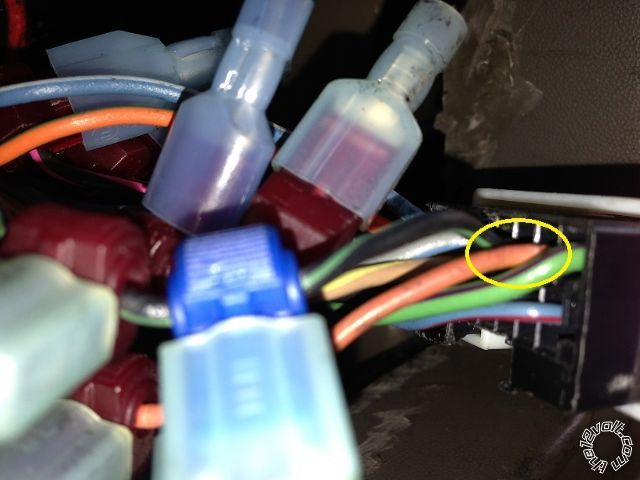
The next pictures are the blue remote lead "wire' from the amp to this orange wire on the factory wiring harness?
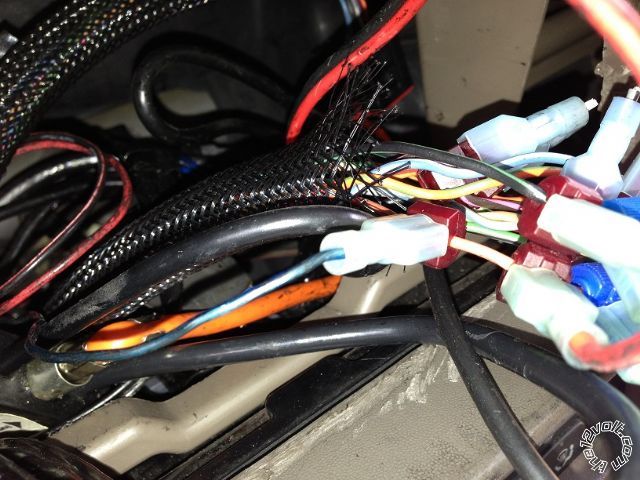
Remote lead "wire"
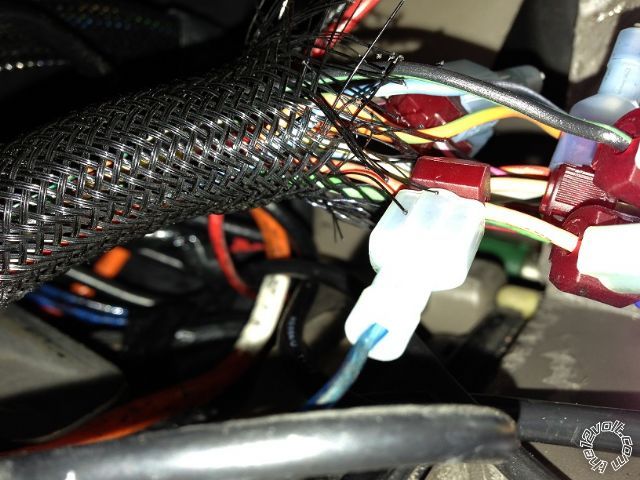
Does anyone have a clue what this orange wire is? also shouldn't this blue remote lead plug into the deck and not the factory wiring harness?
After pulling out the factory wiring harness so i could get a better look at it I've noticed that the previous owner had an aftermarket rear entertainment dvd player and who ever installed it used a combination of quick splice connecters and T-tap connectors onto the factory wiring harness.
Yikes!
Thanks again for the help
02EX
I found out where the blue remote lead "wire' is connected to ....it's connected to what I believe is an orange wire to the factory wiring harness?
Here is a picture of the back of the factory wiring harness..

The next pictures are the blue remote lead "wire' from the amp to this orange wire on the factory wiring harness?

Remote lead "wire"

Does anyone have a clue what this orange wire is? also shouldn't this blue remote lead plug into the deck and not the factory wiring harness?
After pulling out the factory wiring harness so i could get a better look at it I've noticed that the previous owner had an aftermarket rear entertainment dvd player and who ever installed it used a combination of quick splice connecters and T-tap connectors onto the factory wiring harness.
Yikes!
Thanks again for the help
02EX
Posted By: 02excursion
Date Posted: November 03, 2013 at 2:35 PM
I checked the following below....
Passenger side battery with the EX off
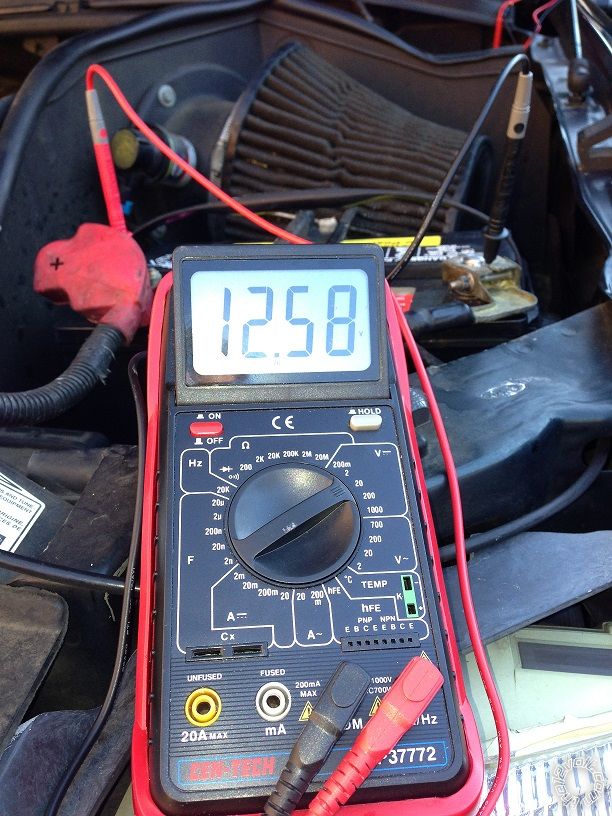
Driver side battery with the EX off
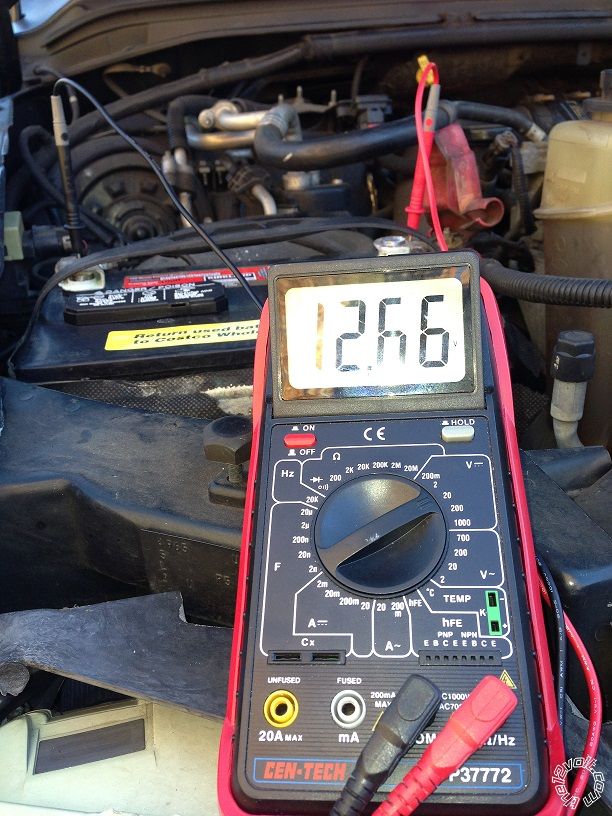
Passenger side battery with EX running
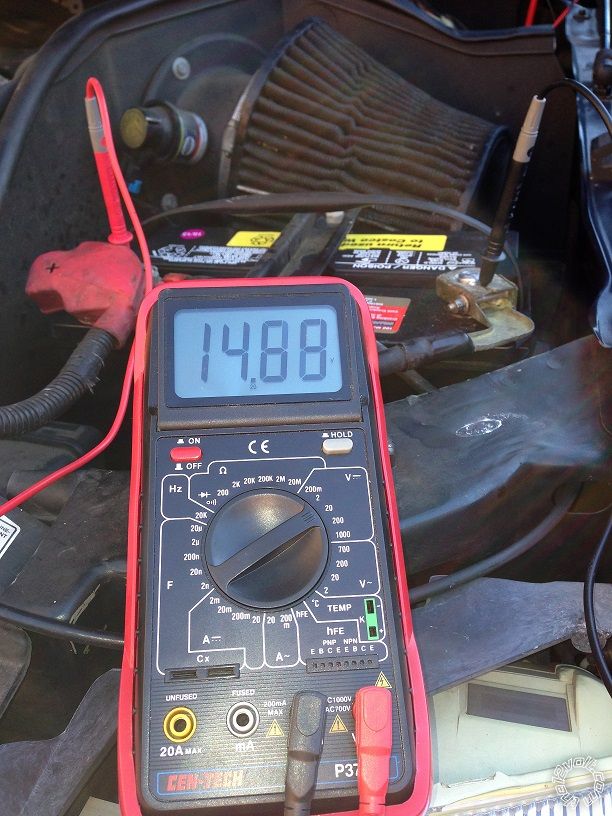
Driver side battery with EX running
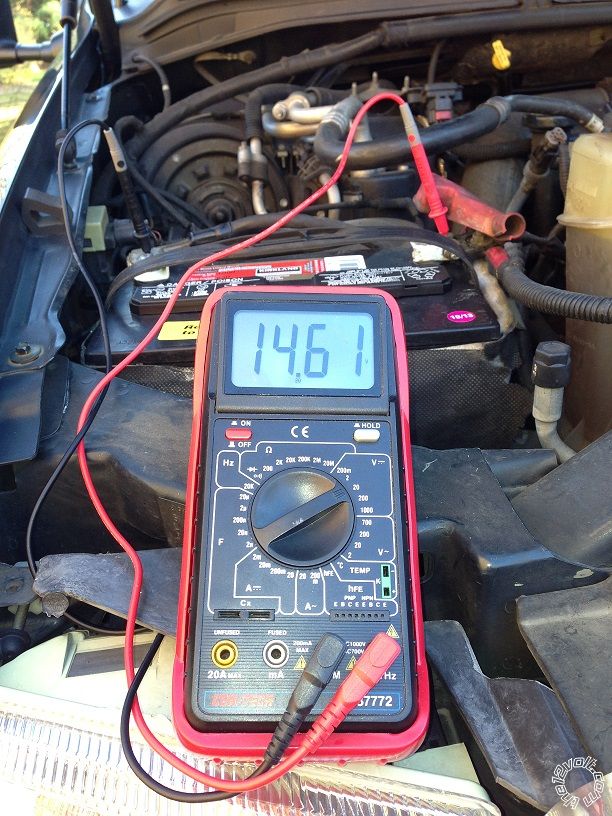
Passenger side battery running with the lights and heater on.
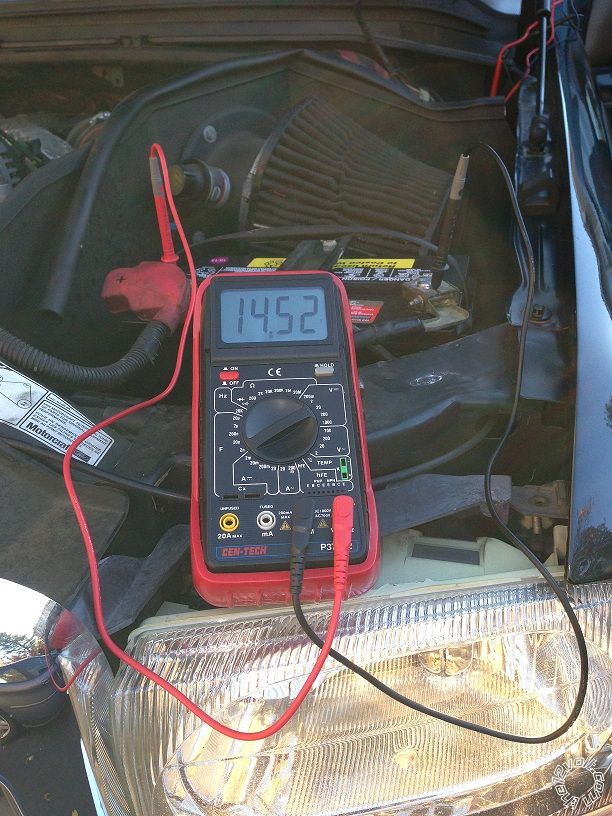
Driver side battery running with the lights and heater on.
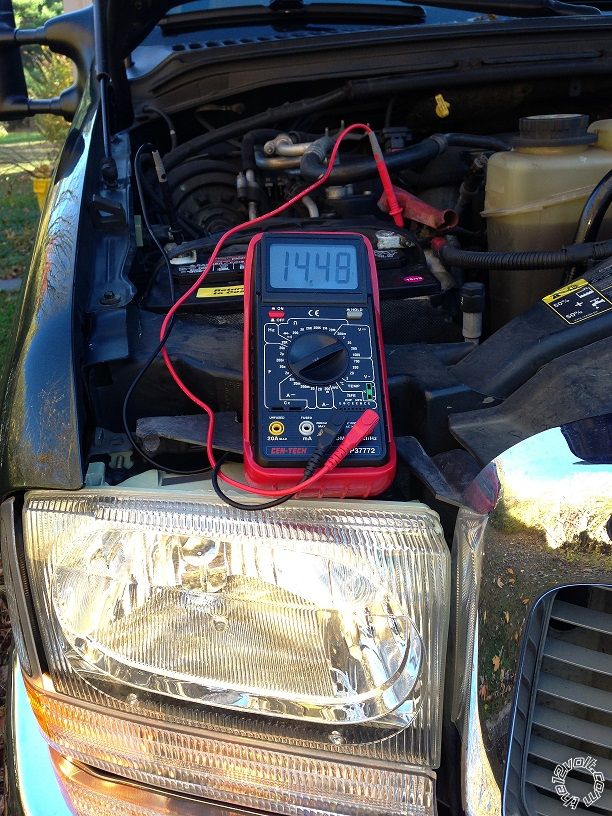
The batteries check fine (which they should they are brand new). The DC power alternator also checks fine as well from the volt test and with the draw on it too.
Thanks again
02EX
Passenger side battery with the EX off

Driver side battery with the EX off

Passenger side battery with EX running

Driver side battery with EX running

Passenger side battery running with the lights and heater on.

Driver side battery running with the lights and heater on.

The batteries check fine (which they should they are brand new). The DC power alternator also checks fine as well from the volt test and with the draw on it too.
Thanks again
02EX
Posted By: oldspark
Date Posted: November 03, 2013 at 9:51 PM
Your charge voltage is too high. It should be a maximum of 14.4V though initial higher voltages may be acceptable.
Also interesting the voltage differences between the 2 batteries.
12.58V vs 12.66V means an almost 10% SOC (state of charge) difference. Why?
14.88V vs 14.61V might be too high a voltage drop. However both are too high and therefore maybe higher than normal currents.
(14.52V vs 14.48 is still too high and suggests light power is taken from the passenger side/battery.)
Definitely check your alternator as those voltages will boil wet cells and ruin sealed batteries.
If it has a Sense (S) wire, ensure it is intact and properly connected to the battery +12V.
Many Sense wires have a fuse (typically 7.5A even though they only consume tens of mA at the most).
(Most alternators go high if the Sense is not connected.)
Also check if your battery/engine/chassis ground is ok, tho I expect that to be good since the voltage is more likely to increase with increasing load if there is a bad GND.
But when running, check that the voltage across the battery & battery +12V to chassis/body & the +12V supply to the main fusebox (busbar or inputs) are the same or very close.
Also interesting the voltage differences between the 2 batteries.
12.58V vs 12.66V means an almost 10% SOC (state of charge) difference. Why?
14.88V vs 14.61V might be too high a voltage drop. However both are too high and therefore maybe higher than normal currents.
(14.52V vs 14.48 is still too high and suggests light power is taken from the passenger side/battery.)
Definitely check your alternator as those voltages will boil wet cells and ruin sealed batteries.
If it has a Sense (S) wire, ensure it is intact and properly connected to the battery +12V.
Many Sense wires have a fuse (typically 7.5A even though they only consume tens of mA at the most).
(Most alternators go high if the Sense is not connected.)
Also check if your battery/engine/chassis ground is ok, tho I expect that to be good since the voltage is more likely to increase with increasing load if there is a bad GND.
But when running, check that the voltage across the battery & battery +12V to chassis/body & the +12V supply to the main fusebox (busbar or inputs) are the same or very close.